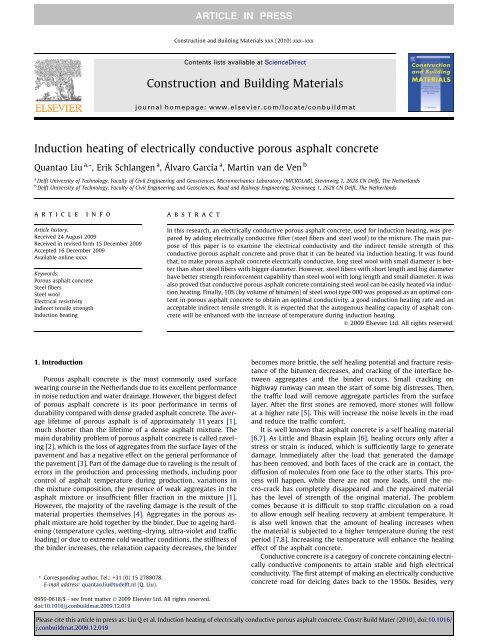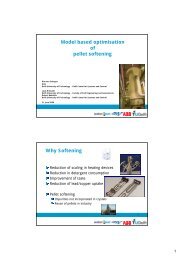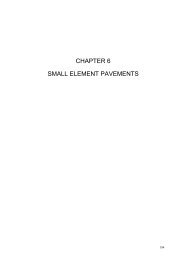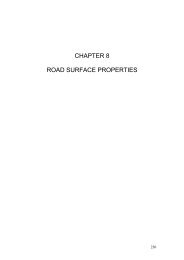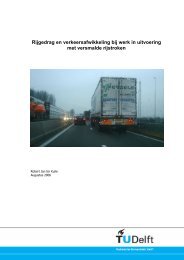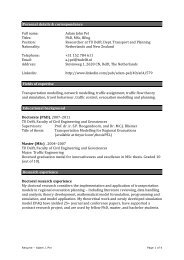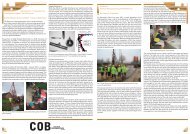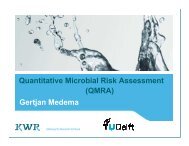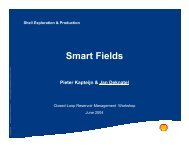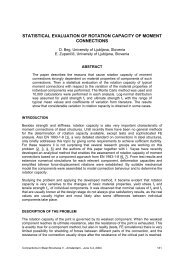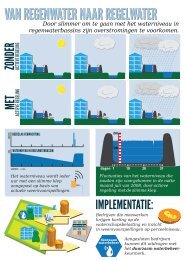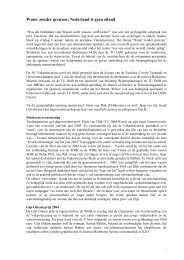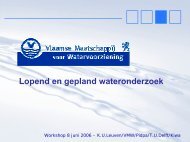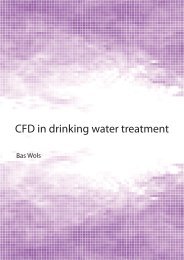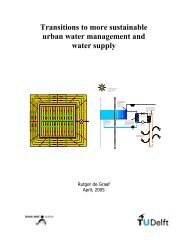Induction heating of electrically conductive porous asphalt ... - TU Delft
Induction heating of electrically conductive porous asphalt ... - TU Delft
Induction heating of electrically conductive porous asphalt ... - TU Delft
Create successful ePaper yourself
Turn your PDF publications into a flip-book with our unique Google optimized e-Paper software.
ARTICLE IN PRESS<br />
Construction and Building Materials xxx (2010) xxx–xxx<br />
Contents lists available at ScienceDirect<br />
Construction and Building Materials<br />
journal homepage: www.elsevier.com/locate/conbuildmat<br />
<strong>Induction</strong> <strong>heating</strong> <strong>of</strong> <strong>electrically</strong> <strong>conductive</strong> <strong>porous</strong> <strong>asphalt</strong> concrete<br />
Quantao Liu a, *, Erik Schlangen a , Álvaro García a , Martin van de Ven b<br />
a <strong>Delft</strong> University <strong>of</strong> Technology, Faculty <strong>of</strong> Civil Engineering and Geosciences, Micromechanics Laboratory (MICROLAB), Stevinweg 1, 2628 CN <strong>Delft</strong>, The Netherlands<br />
b <strong>Delft</strong> University <strong>of</strong> Technology, Faculty <strong>of</strong> Civil Engineering and Geosciences, Road and Railway Engineering, Stevinweg 1, 2628 CN <strong>Delft</strong>, The Netherlands<br />
article<br />
info<br />
abstract<br />
Article history:<br />
Received 24 August 2009<br />
Received in revised form 15 December 2009<br />
Accepted 16 December 2009<br />
Available online xxxx<br />
Keywords:<br />
Porous <strong>asphalt</strong> concrete<br />
Steel fibers<br />
Steel wool<br />
Electrical resistivity<br />
Indirect tensile strength<br />
<strong>Induction</strong> <strong>heating</strong><br />
In this research, an <strong>electrically</strong> <strong>conductive</strong> <strong>porous</strong> <strong>asphalt</strong> concrete, used for induction <strong>heating</strong>, was prepared<br />
by adding <strong>electrically</strong> <strong>conductive</strong> filler (steel fibers and steel wool) to the mixture. The main purpose<br />
<strong>of</strong> this paper is to examine the electrical conductivity and the indirect tensile strength <strong>of</strong> this<br />
<strong>conductive</strong> <strong>porous</strong> <strong>asphalt</strong> concrete and prove that it can be heated via induction <strong>heating</strong>. It was found<br />
that, to make <strong>porous</strong> <strong>asphalt</strong> concrete <strong>electrically</strong> <strong>conductive</strong>, long steel wool with small diameter is better<br />
than short steel fibers with bigger diameter. However, steel fibers with short length and big diameter<br />
have better strength reinforcement capability than steel wool with long length and small diameter. It was<br />
also proved that <strong>conductive</strong> <strong>porous</strong> <strong>asphalt</strong> concrete containing steel wool can be easily heated via induction<br />
<strong>heating</strong>. Finally, 10% (by volume <strong>of</strong> bitumen) <strong>of</strong> steel wool type 000 was proposed as an optimal content<br />
in <strong>porous</strong> <strong>asphalt</strong> concrete to obtain an optimal conductivity, a good induction <strong>heating</strong> rate and an<br />
acceptable indirect tensile strength. It is expected that the autogenous healing capacity <strong>of</strong> <strong>asphalt</strong> concrete<br />
will be enhanced with the increase <strong>of</strong> temperature during induction <strong>heating</strong>.<br />
Ó 2009 Elsevier Ltd. All rights reserved.<br />
1. Introduction<br />
Porous <strong>asphalt</strong> concrete is the most commonly used surface<br />
wearing course in the Netherlands due to its excellent performance<br />
in noise reduction and water drainage. However, the biggest defect<br />
<strong>of</strong> <strong>porous</strong> <strong>asphalt</strong> concrete is its poor performance in terms <strong>of</strong><br />
durability compared with dense graded <strong>asphalt</strong> concrete. The average<br />
lifetime <strong>of</strong> <strong>porous</strong> <strong>asphalt</strong> is <strong>of</strong> approximately 11 years [1],<br />
much shorter than the lifetime <strong>of</strong> a dense <strong>asphalt</strong> mixture. The<br />
main durability problem <strong>of</strong> <strong>porous</strong> <strong>asphalt</strong> concrete is called raveling<br />
[2], which is the loss <strong>of</strong> aggregates from the surface layer <strong>of</strong> the<br />
pavement and has a negative effect on the general performance <strong>of</strong><br />
the pavement [3]. Part <strong>of</strong> the damage due to raveling is the result <strong>of</strong><br />
errors in the production and processing methods, including poor<br />
control <strong>of</strong> <strong>asphalt</strong> temperature during production, variations in<br />
the mixture composition, the presence <strong>of</strong> weak aggregates in the<br />
<strong>asphalt</strong> mixture or insufficient filler fraction in the mixture [1].<br />
However, the majority <strong>of</strong> the raveling damage is the result <strong>of</strong> the<br />
material properties themselves [4]. Aggregates in the <strong>porous</strong> <strong>asphalt</strong><br />
mixture are hold together by the binder. Due to ageing hardening<br />
(temperature cycles, wetting–drying, ultra-violet and traffic<br />
loading) or due to extreme cold weather conditions, the stiffness <strong>of</strong><br />
the binder increases, the relaxation capacity decreases, the binder<br />
* Corresponding author. Tel.: +31 (0) 15 2788078.<br />
E-mail address: quantao.liu@tudelft.nl (Q. Liu).<br />
becomes more brittle, the self healing potential and fracture resistance<br />
<strong>of</strong> the bitumen decreases, and cracking <strong>of</strong> the interface between<br />
aggregates and the binder occurs. Small cracking on<br />
highway runway can mean the start <strong>of</strong> some big distresses. Then,<br />
the traffic load will remove aggregate particles from the surface<br />
layer. After the first stones are removed, more stones will follow<br />
at a higher rate [5]. This will increase the noise levels in the road<br />
and reduce the traffic comfort.<br />
It is well known that <strong>asphalt</strong> concrete is a self healing material<br />
[6,7]. As Little and Bhasin explain [6], healing occurs only after a<br />
stress or strain is induced, which is sufficiently large to generate<br />
damage. Immediately after the load that generated the damage<br />
has been removed, and both faces <strong>of</strong> the crack are in contact, the<br />
diffusion <strong>of</strong> molecules from one face to the other starts. This process<br />
will happen, while there are not more loads, until the micro-crack<br />
has completely disappeared and the repaired material<br />
has the level <strong>of</strong> strength <strong>of</strong> the original material. The problem<br />
comes because it is difficult to stop traffic circulation on a road<br />
to allow enough self healing recovery at ambient temperature. It<br />
is also well known that the amount <strong>of</strong> healing increases when<br />
the material is subjected to a higher temperature during the rest<br />
period [7,8]. Increasing the temperature will enhance the healing<br />
effect <strong>of</strong> the <strong>asphalt</strong> concrete.<br />
Conductive concrete is a category <strong>of</strong> concrete containing <strong>electrically</strong><br />
<strong>conductive</strong> components to attain stable and high electrical<br />
conductivity. The first attempt <strong>of</strong> making an <strong>electrically</strong> <strong>conductive</strong><br />
concrete road for deicing dates back to the 1950s. Besides, very<br />
0950-0618/$ - see front matter Ó 2009 Elsevier Ltd. All rights reserved.<br />
doi:10.1016/j.conbuildmat.2009.12.019<br />
Please cite this article in press as: Liu Q et al. <strong>Induction</strong> <strong>heating</strong> <strong>of</strong> <strong>electrically</strong> <strong>conductive</strong> <strong>porous</strong> <strong>asphalt</strong> concrete. Constr Build Mater (2010), doi:10.1016/<br />
j.conbuildmat.2009.12.019
ARTICLE IN PRESS<br />
2 Q. Liu et al. / Construction and Building Materials xxx (2010) xxx–xxx<br />
recently Sherif et al. [9] and Tuan [10] made <strong>conductive</strong> concrete<br />
containing steel fibers and shavings for bridge deck deicing.<br />
Electrically <strong>conductive</strong> <strong>asphalt</strong> concrete is a relatively new<br />
functional material developed to achieve electrical conductivity.<br />
To reach this property, <strong>conductive</strong> filler or fibers should be added<br />
to the mixture. Wu et al. [11] made the first <strong>electrically</strong> <strong>conductive</strong><br />
mixture by adding <strong>conductive</strong> carbon fibers, carbon black or graphite<br />
to the <strong>asphalt</strong> concrete. They demonstrated that the conductivity<br />
is proportional to the volume <strong>of</strong> <strong>conductive</strong> filler or fibers<br />
added. An excess <strong>of</strong> <strong>conductive</strong> particles can cause the degradation<br />
<strong>of</strong> the <strong>asphalt</strong> concrete properties, such as the strength or the<br />
workability <strong>of</strong> fresh materials. Finally, they showed that adding<br />
<strong>conductive</strong> fibers to the mixture is much more effective to increase<br />
the conductivity than adding <strong>conductive</strong> filler. In addition, García<br />
et al. [12] show how the conductivity is proportional to the volume<br />
<strong>of</strong> aggregates in the mixture and how there is an optimum volume<br />
<strong>of</strong> <strong>electrically</strong> <strong>conductive</strong> particles for each mixture. These authors<br />
explain the <strong>conductive</strong> mechanism by means <strong>of</strong> the percolation<br />
theory. With a low volume <strong>of</strong> <strong>conductive</strong> particles in the mixture,<br />
the resistivity <strong>of</strong> <strong>asphalt</strong> concrete is that <strong>of</strong> a non <strong>conductive</strong> material,<br />
but when the volume <strong>of</strong> <strong>conductive</strong> particles is above the percolation<br />
threshold, the resistivity drops and the sample becomes<br />
<strong>conductive</strong>.<br />
It is theoretically feasible to repair cracks in <strong>asphalt</strong> concrete<br />
before they become too big to be healed. The use <strong>of</strong> fibers to<br />
reinforce binder has long been in practice. In this research, <strong>conductive</strong><br />
steel fibers are added to the <strong>asphalt</strong> mixture and induction<br />
<strong>heating</strong> is used to increase the temperature locally, just<br />
enough to increase the <strong>asphalt</strong> healing rates and repair microcracks<br />
or the bond between aggregates and binder. The main<br />
objective <strong>of</strong> using <strong>conductive</strong> fibers is to increase the conductivity<br />
<strong>of</strong> binder so that micro-cracks can be healed via induction<br />
<strong>heating</strong>. <strong>Induction</strong> <strong>heating</strong> in the <strong>asphalt</strong> industry is a novel technique<br />
originally developed by García et al. [12]. In this method,<br />
the power supply sends alternating current through the coil, generating<br />
an alternating electromagnetic field. When the <strong>conductive</strong><br />
<strong>asphalt</strong> specimen is placed under the coil, this electromagnetic<br />
field induces currents flowing along the <strong>conductive</strong> loops formed<br />
by steel fibers. The induced current dissipates heat by the Joule<br />
effect. This method can be repeated if damage returns. Traditionally,<br />
in <strong>conductive</strong> roads, heat was generated due to the electrical<br />
resistance in the <strong>conductive</strong> particles when connected to a power<br />
source, but in this occasion, authors are trying to make <strong>porous</strong><br />
<strong>asphalt</strong> concrete appropriate for induction <strong>heating</strong> and the subsequent<br />
healing <strong>of</strong> cracks. This method has the advantage <strong>of</strong> having<br />
high volumetric <strong>heating</strong> rates. Another advantage <strong>of</strong> using fibers<br />
is that they will probably improve the ageing behavior and the<br />
resistance to water damage <strong>of</strong> bitumen by achieving thicker binder<br />
film and by preventing drain-<strong>of</strong>f <strong>of</strong> the mastic. This may improve<br />
significantly the raveling resistance <strong>of</strong> <strong>porous</strong> <strong>asphalt</strong><br />
concrete.<br />
This will be the first time that this induction <strong>heating</strong> technique<br />
is applied to <strong>porous</strong> <strong>asphalt</strong> concrete. The objectives <strong>of</strong> this research<br />
are:<br />
To study the effect <strong>of</strong> steel fibers volume content on the electrical<br />
conductivity <strong>of</strong> <strong>porous</strong> <strong>asphalt</strong> concrete.<br />
To investigate the effect <strong>of</strong> the steel fibers volume content on the<br />
indirect tensile strength <strong>of</strong> <strong>porous</strong> <strong>asphalt</strong> concrete.<br />
To analyze the effect <strong>of</strong> steel wool volume content on the <strong>heating</strong><br />
rate <strong>of</strong> <strong>porous</strong> <strong>asphalt</strong> concrete.<br />
To explore the relationship between electrical conductivity and<br />
induction <strong>heating</strong> in <strong>porous</strong> <strong>asphalt</strong> concrete.<br />
To optimize the type and volume content <strong>of</strong> steel fibers to obtain<br />
a good electrical conductivity and a high induction <strong>heating</strong> rate<br />
in <strong>porous</strong> <strong>asphalt</strong> concrete.<br />
2. Experimental method<br />
2.1. Materials<br />
The aggregates used to make <strong>porous</strong> <strong>asphalt</strong> concrete specimens were quarry<br />
material (Bestone, Bremanger Quarry, Norway) (size between 2.0 and 22.4 mm<br />
and density 2770 kg/m 3 ), crushed sand (size between 0.063 and 2 mm and density<br />
2688 kg/m 3 ), and filler type Wigro 60 K (size < 0.063 mm and density 2638 kg/m 3 ).<br />
Finally, the bitumen used was 70/100 pen, obtained from Kuwait Petroleum, with<br />
density 1032 kg/m 3 .<br />
Besides, two different types <strong>of</strong> <strong>electrically</strong> <strong>conductive</strong> fibers were mixed in the<br />
<strong>asphalt</strong>. The first one was steel fibers (called steel fiber type 1), with a diameter between<br />
0.0296 mm and 0.1911 mm. The second one was steel wool type 000 with<br />
diameters between 0.00635 mm and 0.00889 mm. These fibers had to be chopped<br />
by hand, always by the same operator. Both types <strong>of</strong> fibers had an approximate density<br />
<strong>of</strong> 7.8 g/cm 3 . These fibers had an electrical resistivity <strong>of</strong> 7 10 7 X cm. To find<br />
the size distribution <strong>of</strong> the <strong>conductive</strong> fillers, more than 100 fibers <strong>of</strong> each type<br />
were checked by taking photographs under the optical microscope and measuring<br />
their length with an image processing program, obtaining the distribution shown in<br />
Fig. 1a and b.<br />
2.2. Porous <strong>asphalt</strong> design<br />
Porous <strong>asphalt</strong> PA 0/16, the most commonly used mixture in the Netherlands,<br />
was used in this research. The mixture composition was fixed based on the Dutch<br />
Standard, RAW 2005 (Table 1) and Gyratory compactor was used to compact the<br />
mixture. These specimens have a diameter <strong>of</strong> 100 mm and a variable thickness between<br />
77.40 and 84.22 mm.<br />
The maximum theoretical density <strong>of</strong> the mixture was 2.569 g/cm 3 . It was calculated<br />
as the total weight divided by the total volume <strong>of</strong> all the materials before compaction.<br />
After mixing, the maximum theoretical density <strong>of</strong> the loose mixture was<br />
measured using an ultrapycnometer 1000 (America, Quantachrome Instruments),<br />
a<br />
Percentage %<br />
b<br />
Percentage %<br />
70<br />
60<br />
50<br />
40<br />
30<br />
20<br />
10<br />
0<br />
25<br />
20<br />
15<br />
10<br />
5<br />
0<br />
0 0.125 0.25 0.5 1.0 2.0<br />
Size <strong>of</strong> steel fiber mm<br />
2 4 6 8 10 12 14 16 18 20 22 24 26 28 30<br />
Size <strong>of</strong> steel wool mm<br />
Fig. 1. Size distribution <strong>of</strong> steel fiber type 1 (a) and steel wool type 000 (b).<br />
Please cite this article in press as: Liu Q et al. <strong>Induction</strong> <strong>heating</strong> <strong>of</strong> <strong>electrically</strong> <strong>conductive</strong> <strong>porous</strong> <strong>asphalt</strong> concrete. Constr Build Mater (2010), doi:10.1016/<br />
j.conbuildmat.2009.12.019
ARTICLE IN PRESS<br />
Q. Liu et al. / Construction and Building Materials xxx (2010) xxx–xxx 3<br />
Table 1<br />
Composition <strong>of</strong> PA 0/16 mixture for Gyratory specimen based on the Dutch standard<br />
(RAW 2005).<br />
Sieve size<br />
(mm)<br />
Density<br />
(g/cm 3 )<br />
which is an instrument for measuring the true volume and density <strong>of</strong> powders,<br />
foams and bulk solids. The maximum theoretical density measured with this apparatus<br />
was 2.571 g/cm 3 , very close to the previously calculated value. The maximum<br />
theoretical density <strong>of</strong> the mixture changes with the variation in volume <strong>of</strong> steel<br />
wool in the mixture and can be computed according to the total weight and volume<br />
<strong>of</strong> all materials in the mixture. The standard calls for a minimum <strong>of</strong> 20% <strong>of</strong> air voids<br />
content. In this case, the air voids content was assumed to be 21%. Based on the<br />
maximum theoretical density, the calculated density <strong>of</strong> the specimen after compaction<br />
and the weight <strong>of</strong> the mixture, the Gyratory compactor can control the height<br />
<strong>of</strong> the specimen to obtain the ultimate target density. The air voids content can be<br />
computed after molding the specimens by determining their dimensions (to compute<br />
their volumes) and weights. The maximum and assumed densities <strong>of</strong> the mixtures<br />
with different volume contents <strong>of</strong> the fibers (the fiber–bitumen volume ratio)<br />
were calculated to obtain the same air void content in all samples studied. The air<br />
voids content for all specimens after compaction was around 21%.<br />
2.3. Electrical resistivity tests<br />
The electrical resistivity measurements were done at room temperature 20 °C.<br />
The samples, with diameter 100 mm and thickness 50 mm were cut from the Gyratory<br />
compacted specimens. After cutting, the samples were placed in an oven at<br />
40 °C during 8 h to remove the moisture and prevent the steel fibers rusting on<br />
the surface <strong>of</strong> the samples. Inside the sample, the steel fibers do not corrode, because<br />
they are completely coated with bitumen. A digital multimeter was used to<br />
measure the resistance below 36 10 6 X. A resistance tester was used to measure<br />
the resistance higher than this value. Two electrodes made <strong>of</strong> 100 mm square copper<br />
plates were connected with resistance tester when testing resistance. Both electrodes<br />
were placed at both ends <strong>of</strong> the test sample to measure the electrical<br />
resistance. A small pressure was applied to the copper electrodes to obtain a good<br />
contact with the surface <strong>of</strong> the sample. The total contact resistance between the two<br />
electrodes was about 0.4 X, which is negligible with respect to the great resistances<br />
studied (higher than 100 kX in the samples). The electrical resistivity was obtained<br />
from the second Ohm-law by<br />
q ¼ RS<br />
ð1Þ<br />
L<br />
where q is the electrical resistivity, L is the internal electrode distance in meter, R is<br />
the measured resistance in omega and S is the electrode <strong>conductive</strong> area in square<br />
meter. The electric field is assumed constant and the end-effects considered<br />
negligible.<br />
2.4. Indirect tensile strength test<br />
RAW spec.<br />
% retained<br />
Cumm.<br />
% ret.<br />
% ret. by<br />
weight<br />
Weight<br />
(g)<br />
22.4–16.0 2.778 0–7 4 4 48<br />
16.0–11.2 2.774 15–30 25 21 252<br />
11.2–8.0 2.762 50–65 57 32 384<br />
8.0–5.6 2.765 70–85 80 23 276<br />
5.6–2.0 2.781 85 85 5 60<br />
2.0–0.063 2.688 95.5 95.5 10.5 126<br />
ARTICLE IN PRESS<br />
4 Q. Liu et al. / Construction and Building Materials xxx (2010) xxx–xxx<br />
<strong>heating</strong> samples were the same as the ones used to measure the electrical resistivity.<br />
The cylindrical samples cut from Gyratory specimens were used to avoid the<br />
problem <strong>of</strong> binder concentration on the surfaces <strong>of</strong> samples and to get a higher<br />
<strong>heating</strong> efficiency for that thinner samples mean less temperature difference between<br />
the top and the bottom <strong>of</strong> the samples. The distance between the coil <strong>of</strong><br />
the induction machine and the top surface <strong>of</strong> the <strong>heating</strong> sample was about<br />
32 mm. Each sample studied was heated for 3 min and its temperature change<br />
was measured with a 640 480 pixel, full color infrared camera.<br />
3. Results and discussions<br />
3.1. Effect <strong>of</strong> <strong>conductive</strong> fiber volume content on the electrical<br />
resistivity <strong>of</strong> <strong>porous</strong> <strong>asphalt</strong> concrete<br />
The effect <strong>of</strong> steel fiber (type 1) volume content on the resistivity<br />
<strong>of</strong> <strong>porous</strong> <strong>asphalt</strong> concrete samples is shown in Fig. 3. The resistivity<br />
<strong>of</strong> the samples shows three stages: high resistivity stage,<br />
with fiber volume content less than 10%; transit stage, with fiber<br />
volume content from 10% to 20%; and low resistivity stage, with fiber<br />
volume content higher than 20%. Samples with less than 10% <strong>of</strong><br />
fibers exhibited insulating behavior, with resistances higher than<br />
10 9 X m. During the transit stage (between 10% and 20% <strong>of</strong> fibers),<br />
the electrical resistivity <strong>of</strong> the sample suffered a sharp decrease<br />
from 10 9 X m to 4.7 10 4 X m. It was discovered that, for the steel<br />
fiber type 1, 20% fibers are needed to make the <strong>porous</strong> <strong>asphalt</strong> concrete<br />
<strong>electrically</strong> <strong>conductive</strong>.<br />
In addition, when drying the sample after cutting, it was found<br />
that plain samples, without steel fibers, glued a little bit to the<br />
plate bellow, showing drainage <strong>of</strong> binder in the sample. However,<br />
samples with steel fibers did not show this phenomenon, which<br />
shows that the steel fibers could prevent the drainage <strong>of</strong> binder.<br />
3.2. Effect <strong>of</strong> <strong>conductive</strong> fiber volume content on the indirect tensile<br />
strength <strong>of</strong> <strong>porous</strong> <strong>asphalt</strong> concrete<br />
The effect <strong>of</strong> steel fibers volume content on the indirect tensile<br />
strength (ITS) <strong>of</strong> <strong>porous</strong> <strong>asphalt</strong> concrete is shown in Fig. 4. The ITS<br />
<strong>of</strong> the plain <strong>porous</strong> <strong>asphalt</strong> concrete studied was 2.06 MPa. The ITS<br />
<strong>of</strong> <strong>porous</strong> <strong>asphalt</strong> concrete increased with the volume <strong>of</strong> steel fibers<br />
until a maximum <strong>of</strong> 2.62 MPa with a steel fibers content <strong>of</strong><br />
11%. Adding more fibers to the mixture results in a decrease <strong>of</strong><br />
the ITS, because too many fibers reduce the mastic film thickness,<br />
causing a bad adhesion between the <strong>asphalt</strong> components. Finally,<br />
samples with 20% <strong>of</strong> steel fibers (the one with highest electrical<br />
1,00E+10<br />
ITS MPa<br />
2.80<br />
2.60<br />
2.40<br />
2.20<br />
2.00<br />
1.80<br />
1.60<br />
0 5 10 15 20 25<br />
Fiber volume content %<br />
Fig. 4. Effect <strong>of</strong> steel fiber type 1 volume content on the ITS <strong>of</strong> <strong>porous</strong> <strong>asphalt</strong><br />
concrete.<br />
conductivity), had a maximum tensile strength <strong>of</strong> 2.03 MPa, close<br />
to that <strong>of</strong> the plain <strong>porous</strong> <strong>asphalt</strong> concrete.<br />
3.3. Electrically <strong>conductive</strong> mechanism in <strong>porous</strong> <strong>asphalt</strong> concrete<br />
Broken <strong>porous</strong> <strong>asphalt</strong> samples after indirect tensile test were<br />
observed under the microscope to check the fibers distribution.<br />
The <strong>conductive</strong> mechanism was explained according to the percolation<br />
theory [15]. Fiber distribution in samples with different contents<br />
<strong>of</strong> steel fibers is shown in Fig. 5. When 5% <strong>of</strong> steel fibers is<br />
added to the mixture, they are uniformly distributed and do not<br />
contact each other, having a similar resistivity to that <strong>of</strong> an <strong>asphalt</strong><br />
concrete sample without fibers. When more steel fibers are added<br />
to the mixture, they start contacting each other, which causes to a<br />
gradual decrease in the resistivity. If the fiber volume content<br />
reaches more than 10% (percolation threshold), the first <strong>conductive</strong><br />
paths are formed in the sample. This corresponds to a sharp decrease<br />
<strong>of</strong> resistivity. Beyond the percolation threshold, the <strong>conductive</strong><br />
network develops and spreads gradually in three dimensions<br />
with the increase <strong>of</strong> the volume content <strong>of</strong> the steel fibers. When<br />
the fiber volume content is more than 20%, steel fibers contact each<br />
other in all directions and many <strong>conductive</strong> networks and passages<br />
are formed, corresponding to a very low value <strong>of</strong> resistivity at<br />
which adding more steel fibers does not reduce the resistivity <strong>of</strong><br />
sample any more.<br />
3.4. Effect <strong>of</strong> bitumen content on the electrical resistivity <strong>of</strong> <strong>porous</strong><br />
<strong>asphalt</strong> concrete<br />
Resistivity Ω.m<br />
1,00E+08<br />
1,00E+06<br />
1,00E+04<br />
0 5 10 15 20 25<br />
Fiber volume content %<br />
Fig. 3. Effect <strong>of</strong> steel fiber type 1 volume content on the resistivity <strong>of</strong> <strong>porous</strong> <strong>asphalt</strong><br />
concrete.<br />
When fibers are added to the mixture, the thickness film <strong>of</strong><br />
mastic around the aggregates is reduced. This can have a negative<br />
effect on the mechanical properties <strong>of</strong> <strong>asphalt</strong> concrete pavements<br />
so, to ensure the durability <strong>of</strong> this <strong>porous</strong> <strong>asphalt</strong>, bitumen content<br />
needs to be increased. In this section, higher bitumen contents<br />
were used to check how the electrical conductivity <strong>of</strong> <strong>porous</strong> <strong>asphalt</strong><br />
concrete was affected. The fiber content was fixed at 20% in<br />
the mixture (for optimal electrical conductivity purpose) and the<br />
bitumen content was gradually increased from 4.5% to 5.4%. The effect<br />
<strong>of</strong> bitumen content on the electrical resistivity <strong>of</strong> <strong>porous</strong> <strong>asphalt</strong><br />
concrete samples is shown in Fig. 6. An increase in the<br />
bitumen content causes a reduction in the electrical resistivity <strong>of</strong><br />
<strong>porous</strong> <strong>asphalt</strong> concrete. Furthermore, ITS reductions from<br />
2.03 MPa to 1.40 MPa were also observed with the increase on<br />
bitumen content.<br />
Please cite this article in press as: Liu Q et al. <strong>Induction</strong> <strong>heating</strong> <strong>of</strong> <strong>electrically</strong> <strong>conductive</strong> <strong>porous</strong> <strong>asphalt</strong> concrete. Constr Build Mater (2010), doi:10.1016/<br />
j.conbuildmat.2009.12.019
ARTICLE IN PRESS<br />
Q. Liu et al. / Construction and Building Materials xxx (2010) xxx–xxx 5<br />
Fig. 5. Steel fibers distribution in the <strong>porous</strong> <strong>asphalt</strong> concrete samples.<br />
1,00E+05<br />
2.1<br />
1,00E+11<br />
Steel fiber type 1<br />
Resistivity Ω.m<br />
1,00E+04<br />
Resistivity<br />
ITS<br />
1.9<br />
1.7<br />
1.5<br />
ITS MPa<br />
Resistivity Ω.m<br />
1,00E+09<br />
1,00E+07<br />
1,00E+05<br />
Steel wool type 000<br />
1,00E+03<br />
1.3<br />
4.2 4.5 4.8 5.1 5.4 5.7<br />
Bitumen content %<br />
Fig. 6. Effect <strong>of</strong> bitumen content on the electrical resistivity and ITS <strong>of</strong> <strong>porous</strong><br />
<strong>asphalt</strong> concrete.<br />
1,00E+03<br />
0 5 10 15 20 25<br />
Fiber volume content %<br />
Fig. 7. Effect <strong>of</strong> fiber volume content on the resistivity <strong>of</strong> the <strong>porous</strong> <strong>asphalt</strong><br />
concrete.<br />
3.5. Effect <strong>of</strong> different type <strong>of</strong> fibers on the electrical resistivity and ITS<br />
<strong>of</strong> <strong>porous</strong> <strong>asphalt</strong> concrete<br />
2.80<br />
2.60<br />
Steel fiber type 1<br />
Steel wool type 000<br />
Fibers size determines the number <strong>of</strong> fibers per unit <strong>of</strong> batched<br />
weight and the number <strong>of</strong> fibers per cubic meter <strong>of</strong> <strong>asphalt</strong> concrete.<br />
Since the total weight, rather than the absolute size determines<br />
the cost <strong>of</strong> the fibers, the question arises whether a large<br />
number <strong>of</strong> short fibers are more effective than the same weight<br />
<strong>of</strong> long fibers. To answer this, steel wool type 000 instead <strong>of</strong> steel<br />
fiber type 1 was used to check if it is better to improve both electrical<br />
conductivity and mechanical properties <strong>of</strong> <strong>porous</strong> <strong>asphalt</strong><br />
concrete.<br />
Comparisons between the effect <strong>of</strong> steel wool type 000 and steel<br />
fiber type 1 volume content on the resistivity and indirect tensile<br />
strength <strong>of</strong> <strong>porous</strong> <strong>asphalt</strong> concrete can be seen in Figs. 7 and 8,<br />
respectively. The high resistivity stage and the low resistivity stage<br />
have almost the same values for both steel wool type 000 and steel<br />
fiber type 1 at 10 9 X m and 10 4 X m, respectively. However, the<br />
transition <strong>of</strong> the steel wool type 000 curve begins at 8%, exhibiting<br />
a lower percolation threshold than that <strong>of</strong> the steel fiber type 1 at<br />
10%. Besides, the transition curve <strong>of</strong> steel wool type 000 is sharper<br />
than the one <strong>of</strong> steel fiber type 1 and reaches the low resistivity<br />
stage at 10% <strong>of</strong> volume <strong>of</strong> steel wool type 000, much earlier than<br />
that <strong>of</strong> steel fiber type 1 at 20% <strong>of</strong> volume <strong>of</strong> steel fibers. So, steel<br />
ITS MPa<br />
2.40<br />
2.20<br />
2.00<br />
1.80<br />
1.60<br />
0 5 10 15 20 25<br />
Fiber volume content %<br />
Fig. 8. Effect <strong>of</strong> fiber volume content on the ITS <strong>of</strong> <strong>porous</strong> <strong>asphalt</strong> concrete.<br />
wool type 000 is much more effective than steel fibers type 1 to enhance<br />
the electrical conductivity <strong>of</strong> <strong>porous</strong> <strong>asphalt</strong> concrete.<br />
In Fig. 8, it can be seen that the indirect tensile strength curve<br />
versus volume <strong>of</strong> steel wool type 000, has the same shape as the<br />
curve for steel fiber type 1. Additions <strong>of</strong> steel wool type 000 below<br />
4% by volume increase the ITS <strong>of</strong> the samples, but too much steel<br />
Please cite this article in press as: Liu Q et al. <strong>Induction</strong> <strong>heating</strong> <strong>of</strong> <strong>electrically</strong> <strong>conductive</strong> <strong>porous</strong> <strong>asphalt</strong> concrete. Constr Build Mater (2010), doi:10.1016/<br />
j.conbuildmat.2009.12.019
ARTICLE IN PRESS<br />
6 Q. Liu et al. / Construction and Building Materials xxx (2010) xxx–xxx<br />
Fig. 9. <strong>Induction</strong> <strong>heating</strong> image <strong>of</strong> a sample with 10% steel wool type 000.<br />
wool results in a decrease <strong>of</strong> the maximum strength <strong>of</strong> <strong>porous</strong> <strong>asphalt</strong><br />
concrete. Steel wool type 000 <strong>of</strong>fers a much weaker reinforcement<br />
than steel fiber type 1. The maximum ITS <strong>of</strong> samples<br />
containing steel wool type 000 happens at around 4% with a value<br />
<strong>of</strong> 2.27 MPa, only slightly higher than the ITS <strong>of</strong> plain samples<br />
without steel wool at a value <strong>of</strong> 2.06 MPa and much lower than<br />
the maximum ITS <strong>of</strong> samples containing about 11% steel fibers at<br />
a value <strong>of</strong> 2.62 MPa. It is very interesting to note that the ITS <strong>of</strong><br />
samples with optimum electrical conductivity containing 10% <strong>of</strong><br />
steel wool type 000 and 20% <strong>of</strong> steel fiber type 1 are 1.99 MPa<br />
and 2.03 MPa, very close to each other. So, steel wool type 000<br />
and steel fiber type 1 have the same effect on the ITS <strong>of</strong> <strong>porous</strong> <strong>asphalt</strong><br />
sample at their respective content for optimal electrical conductivity.<br />
From the point <strong>of</strong> view <strong>of</strong> the electrical conductivity,<br />
steel wool type 000 has better performance than steel fibers.<br />
3.6. <strong>Induction</strong> <strong>heating</strong> <strong>of</strong> <strong>porous</strong> <strong>asphalt</strong> concrete<br />
To study the induction <strong>heating</strong> <strong>of</strong> <strong>porous</strong> <strong>asphalt</strong> concrete, samples<br />
containing steel wool type 000 were used. Fig. 9 shows an<br />
induction <strong>heating</strong> image <strong>of</strong> the sample with 10% steel wool. All<br />
samples have the similar images like this. On the top surface <strong>of</strong><br />
the sample, clusters <strong>of</strong> steel wool work as small heaters. This corresponds<br />
to the shining dots on the surface <strong>of</strong> the sample in Fig. 9.<br />
The image shows uniform temperature in the horizontal direction.<br />
This is because the magnetic field is constant at the same distance<br />
from the coil. The temperature <strong>of</strong> the sample decreases from top to<br />
bottom. It was also found that samples had a higher <strong>heating</strong> rate<br />
when they were closer to the coil <strong>of</strong> the induction machine. The<br />
reason for this is that the magnetic field is stronger close to the<br />
coil. Finding the optimum distance between the pavement and<br />
the coil will be a topic for future study.<br />
The temperatures <strong>of</strong> all the samples with different steel wool<br />
volume contents were recorded and used to analyze the effect <strong>of</strong><br />
the steel wool content on the <strong>heating</strong> rate <strong>of</strong> <strong>porous</strong> <strong>asphalt</strong> samples<br />
(Fig. 10). The plain sample without steel wool was almost not<br />
heated in 3 min because <strong>of</strong> the very low <strong>heating</strong> speed. Below 10%<br />
<strong>of</strong> steel wool in the mixture, the temperature reached increased<br />
with the increase <strong>of</strong> the volume content <strong>of</strong> steel wool. The samples<br />
could be heated, even if hey were not <strong>conductive</strong>, but the <strong>heating</strong><br />
rate was lower. The temperature cannot be increased any more<br />
when the steel wool volume content is above 10%. This value coincides<br />
with the minimum in the resistivity curve in Fig. 8. The minimum<br />
resistivity will result in a maximum Joule heat in the<br />
sample; hence the temperature will be also a maximum. Adding<br />
steel wool above 10% does not improve the <strong>heating</strong> and will result<br />
in a decrease <strong>of</strong> the indirect tensile strength, as shown in Fig. 8. So,<br />
Temperature ºC<br />
160<br />
140<br />
120<br />
100<br />
80<br />
60<br />
40<br />
20<br />
0<br />
10% is the optimal volume content <strong>of</strong> this type <strong>of</strong> steel wool to heat<br />
easily <strong>porous</strong> <strong>asphalt</strong> concrete.<br />
4. Conclusions<br />
30s<br />
90s<br />
150s<br />
0 2 4 6 8 10 12 14 16<br />
Steel wool volume content %<br />
It was found that long steel wool type 000, is better than short<br />
steel fiber type 1 to make <strong>porous</strong> <strong>asphalt</strong> concrete <strong>electrically</strong> <strong>conductive</strong>.<br />
However, short steel fibers have better strength reinforcement<br />
capacity than steel wool. The mechanisms <strong>of</strong> electrical<br />
conductivity and induction <strong>heating</strong> are explained in this paper.<br />
10% (by volume <strong>of</strong> bitumen) <strong>of</strong> steel wool type 000 is proposed<br />
as an ideal content to make <strong>porous</strong> <strong>asphalt</strong> concrete <strong>conductive</strong><br />
and for a fast induction <strong>heating</strong>. Besides, this value gives an acceptable<br />
indirect tensile strength to <strong>porous</strong> <strong>asphalt</strong> concrete. Adding<br />
more bitumen for durability purpose can increase the electrical<br />
conductivity <strong>of</strong> <strong>porous</strong> <strong>asphalt</strong> concrete, but it can also decrease<br />
its indirect tensile strength. It is expected that the self-healing<br />
capacity <strong>of</strong> <strong>asphalt</strong> concrete will be enhanced with the induction<br />
<strong>heating</strong>, although this is a matter for future study.<br />
5. Further research plan<br />
60s<br />
120s<br />
180s<br />
Fig. 10. Effect <strong>of</strong> steel wool type 000 volume content on the <strong>heating</strong> rate <strong>of</strong> <strong>porous</strong><br />
<strong>asphalt</strong> concrete.<br />
It has been proved that the <strong>electrically</strong> <strong>conductive</strong> <strong>porous</strong> <strong>asphalt</strong><br />
concrete can be heated quickly with induction energy. However,<br />
work needs to be done to detect the healing effect <strong>of</strong> this<br />
<strong>porous</strong> <strong>asphalt</strong> concrete. The idea is to introduce some damage<br />
Please cite this article in press as: Liu Q et al. <strong>Induction</strong> <strong>heating</strong> <strong>of</strong> <strong>electrically</strong> <strong>conductive</strong> <strong>porous</strong> <strong>asphalt</strong> concrete. Constr Build Mater (2010), doi:10.1016/<br />
j.conbuildmat.2009.12.019
ARTICLE IN PRESS<br />
Q. Liu et al. / Construction and Building Materials xxx (2010) xxx–xxx 7<br />
to the <strong>porous</strong> <strong>asphalt</strong> concrete samples, and then heat the samples<br />
with induction energy to see if the damage can be healed or not.<br />
Strength recovery can serve as a healing index and CT scanning<br />
can serve as a method to see the cracks occurring and closing inside<br />
the material. In addition, more researches related to practical<br />
implementation <strong>of</strong> this kind <strong>of</strong> material will be done.<br />
Acknowledgements<br />
The scholarship from the China Scholarship Council is acknowledged.<br />
The technical support <strong>of</strong> Pr<strong>of</strong>. Klaas van Breugel, Pr<strong>of</strong>. A.A.A.<br />
Molenaar and Marco Poot are also appreciated. Furthermore, the<br />
authors would like to express thanks to Global Material Technologies<br />
for their technical expertise and advices about steel wool.<br />
References<br />
[1] Voskuilen JLM, Verhoef PNW. Cause <strong>of</strong> premature raveling failure <strong>of</strong> <strong>porous</strong><br />
<strong>asphalt</strong>. In: Sixth international RILEM symposium on performance testing and<br />
evaluation <strong>of</strong> bituminous materials; 2003. p. 191–97.<br />
[2] Klomp AJG. Life period <strong>of</strong> <strong>porous</strong> <strong>asphalt</strong>. Dutch Road and Hydraulic<br />
Engineering Institute report; 1996.<br />
[3] Swart JH. Experience with <strong>porous</strong> <strong>asphalt</strong> in the Netherlands. In: European<br />
conference on <strong>porous</strong> <strong>asphalt</strong>. Madrid; 1997.<br />
[4] Eijssen MLJ, Klarenaar WHM. Zwart Mozaïek, evaluatie van bestaande kennis<br />
en kennisleemten als basis voor de levensduurverbetering van 2-laags ZOAB.<br />
Intron-report A831100/R20060101/MEy; 2006.<br />
[5] Kneepkens A, van Ho<strong>of</strong> Th, Schaefer H, van Keulen W. VIA-RAL Ò for <strong>porous</strong><br />
<strong>asphalt</strong>: a result <strong>of</strong> research and development, but most <strong>of</strong> all <strong>of</strong><br />
implementation. Wegbouwkundige Werkdagen; 2004.<br />
[6] Little DN, Bhasin A. Exploring mechanisms <strong>of</strong> healing in <strong>asphalt</strong> mixtures and<br />
quantifying its impact. In: van der Zwaag S, editor. Self healing materials an<br />
alternative approach to 20 centuries <strong>of</strong> materials science. Springer series in<br />
materials science, vol. 100; 2007. p. 205–18.<br />
[7] Jo SD, Richard KY. Laboratory evaluation <strong>of</strong> fatigue damage and healing <strong>of</strong><br />
<strong>asphalt</strong> mixtures. J Mater Civ Eng 2001;13(6):434–40.<br />
[8] Bonnaure FP, Huibers AH, Boonders A. A laboratory investigation <strong>of</strong> the<br />
influence <strong>of</strong> rest periods on the fatigue characteristics <strong>of</strong> bituminous mixes. J<br />
Assoc Asphalt Pav Technol 1982;51:104–28.<br />
[9] Sherif YH, Christopher YT. Conductive concrete overlay for bridge deck deicing.<br />
ACI Mater J 1999;96(3):382–90.<br />
[10] Tuan CY. Electrical resistance <strong>heating</strong> <strong>of</strong> <strong>conductive</strong> concrete containing steel<br />
fibers and shavings. ACI Mater J 2004;101(1):65–71.<br />
[11] Wu S, Liu X, Ye Q, Li N. Self-monitoring <strong>electrically</strong> <strong>conductive</strong> <strong>asphalt</strong>-based<br />
composite containing carbon fillers. Trans Nonferr Met Soc China<br />
2006;16:512–6.<br />
[12] García Álvaro, Schlangen Erik, van de Ven Martin, Liu Quantao. Electrical<br />
conductivity <strong>of</strong> <strong>asphalt</strong> mortar containing <strong>conductive</strong> fibers and fillers.<br />
Construct Build Mater 2009;23(10):3175–81.<br />
[13] Yuzhi Li. Using compaction parameters and indirect tensile strength to<br />
evaluate <strong>asphalt</strong> concrete rutting potential. Master thesis, Changsha<br />
University <strong>of</strong> Technology, China; 2007.<br />
[14] Behbahani H, Nowbakht S, Fazaeli H, Rahmani J. Effects <strong>of</strong> fiber type and<br />
content on the rutting performance <strong>of</strong> stone matrix <strong>asphalt</strong>. J Appl Sci<br />
2009;9(10):1980–4.<br />
[15] Stauffer D. Introduction to percolation theory. London: Taylor and Francis;<br />
1985.<br />
Please cite this article in press as: Liu Q et al. <strong>Induction</strong> <strong>heating</strong> <strong>of</strong> <strong>electrically</strong> <strong>conductive</strong> <strong>porous</strong> <strong>asphalt</strong> concrete. Constr Build Mater (2010), doi:10.1016/<br />
j.conbuildmat.2009.12.019


